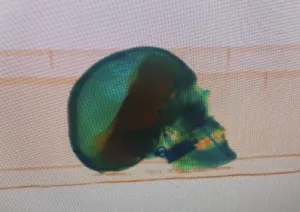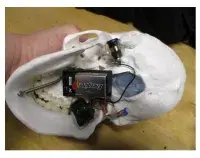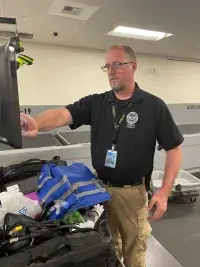
When Salt Lake City International Airport (SLC) TSA Officer Justin Buttars looked at the image on the screen in the checked baggage resolution area (CBRA), staring back at him was a suspicious and downright creepy item that appeared to be oozing a black, sticky substance.
It would have been easy for Buttars to allow the spooky image to unnerve him, but true to his training, he kept his head and focused on what appeared to be a skull with a nine-volt battery, wires and two unidentifiable electronic items attached to its jaw.
“My first question was, ‘Is this a Halloween prop?’” said Lead TSA Manager Krystal Green when she was first informed of the incident.
“The image appeared to have all the components of an improvised explosive device to include a power supply, initiator, explosives and a switch,” said SLC Assistant Federal Security Director for Screening Russell Sitz.
“I confirmed the object was an obvious threat,” said Buttars, who then called his supervisor, TSA Supervisory Officer Harley Higgs. Upon conferring, Higgs quickly concurred with Buttars and requested a Transportation Security Specialist-Explosives (TSS-E).
After a negative explosives trace detection swab by TSS-E Bradley Somerville, Buttars and Higgs took another long look at the bag contents.
“I saw two virtual reality headsets and nothing else of interest,” confirmed Buttars.
“We opened the bag and found the plastic skull. Its cranium showed a cut line along the crown with a black, sticky substance leaking from the left side,” said Higgs. “When viewed from the bottom, a blue substance could be seen held in by clear tape.”
When contacted about the contents of his bag, the owner said the plastic skull was a training aid for neurosurgery and was being taken to a continuing education seminar and trade show in Cancun, Mexico.
“We became unsure of the skull and its potential threat; therefore, I barred the item from travel and agreed with TSS-E Somerville to evacuate the CBRA and the baggage handling station (until the threat was mitigated),” said Higgs.
As TSA spokesperson Lorie Dankers reported in a press release, “TSA notified the Salt Lake City Police Airport Division who worked with the agency’s explosives specialist to mitigate the immediate threat through the use of an explosives detection canine.”
Sitz added a disassembled and properly labeled medical training device, including company contact information, would have made this haunting case a treat instead of a trick.
“This incident and subsequent response is an example of how TSA must take every potential security threat seriously while making sure the transportation system is not put at risk,” said TSA Utah Federal Security Director Matt Davis. “I was pleased at the professionalism of everyone involved who worked closely to fully resolve the matter to ensure that security was not compromised, and to resume operations as quickly possible.”
By Karen Robicheaux, TSA Strategic Communications and Public Affairs


